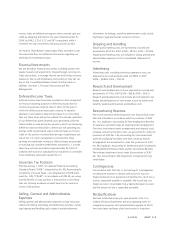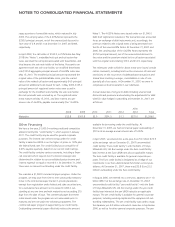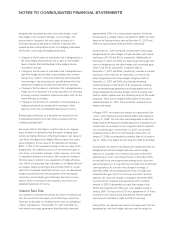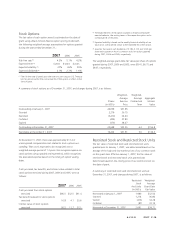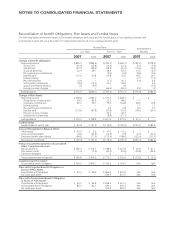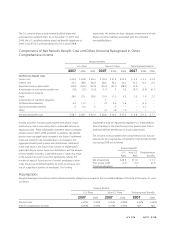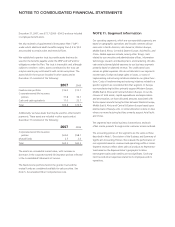Avon 2007 Annual Report Download - page 69
Download and view the complete annual report
Please find page 69 of the 2007 Avon annual report below. You can navigate through the pages in the report by either clicking on the pages listed below, or by using the keyword search tool below to find specific information within the annual report.
exposure to the possible rise in interest rates prior to the issu-
ance of the 4.625% Notes. The loss of $2.6 was recorded in
AOCI and is being amortized to interest expense over ten years.
At December 31, 2007 and 2006, AOCI includes remaining
unamortized losses of $27.9 and $3.3 ($18.1 and $2.1 net of
taxes), respectively, resulting from treasury lock agreements.
Foreign Currency Risk
We use foreign currency forward contracts and options to hedge
portions of our forecasted foreign currency cash flows resulting
from intercompany royalties, intercompany loans, and other
third-party and intercompany foreign currency transactions
where there is a high probability that anticipated exposures will
materialize. These contracts have been designated as cash flow
hedges. The primary currencies for which we have net under-
lying foreign currency exchange rate exposures are the Argentine
peso, Brazilian real, British pound, Canadian dollar, Chinese
renminbi, Colombian peso, the Euro, Japanese yen, Mexican
peso, Polish zloty, Russian ruble, Turkish lira and Venezuelan
bolivar.
For the years ended December 31, 2007, 2006 and 2005, the
ineffective portion of our cash flow foreign currency derivative
instruments and the net gains or losses reclassified from AOCI to
earnings for cash flow hedges that had been discontinued
because the forecasted transactions were not probable of occur-
ring were not material.
At December 31, 2007, the maximum remaining term over
which we were hedging foreign exchange exposures to the
variability of cash flows for all forecasted transactions was 12
months. As of December 31, 2007, we expect to reclassify
$17.7, net of taxes, of net losses on derivative instruments des-
ignated as cash flow hedges from AOCI to earnings during the
next 12 months due to (a) foreign currency denominated inter-
company royalties, (b) intercompany loan settlements and
(c) foreign currency denominated purchases or receipts.
For the years ended December 31, 2007 and 2006, cash flow
hedges impacted AOCI as follows:
2007 2006
Net derivative losses at beginning of year $ (.3) $ (1.3)
Net gains on derivative instruments,
net of taxes of $12.2 and $1.2 16.8 10.1
Reclassification of net gains to earnings,
net of taxes of $2.7 and $1.3 (34.2) (9.1)
Net derivative losses at end of year, net of
taxes of $9.7 and $.2 $(17.7) $ (.3)
We use foreign currency forward contracts and foreign currency-
denominated debt to hedge the foreign currency exposure
related to the net assets of certain of our foreign subsidiaries. At
December 31, 2007, we had a Japanese yen-denominated note
payable to hedge our net investment in our Japanese subsidiary
(see Note 4, Debt and Other Financing). For the years ended
December 31, 2007, 2006 and 2005, $9.7, $6.1 and $7.3,
respectively, related to the effective portions of these hedges
were included in foreign currency translation adjustments within
AOCI on the Consolidated Balance Sheets.
At December 31, 2007 and 2006, we held foreign currency
forward contracts and option contracts with fair values totaling
$2.8 and $7.9, respectively, recorded in accounts payable.
Credit and Market Risk
We attempt to minimize our credit exposure to counterparties by
entering into interest rate swap and foreign currency forward
rate and option agreements only with major international finan-
cial institutions with “A” or higher credit ratings as issued by
Standard & Poor’s Corporation. Our foreign currency and inter-
est rate derivatives are comprised of over-the-counter forward
contracts, swaps or options with major international financial
institutions. Although our theoretical credit risk is the replace-
ment cost at the then estimated fair value of these instruments,
we believe that the risk of incurring credit risk losses is remote
and that such losses, if any, would not be material.
Non-performance of the counterparties on the balance of all the
foreign exchange and interest rate agreements would result in a
write-off of $19.9 at December 31, 2007. In addition, in the
event of non-performance by such counterparties, we would be
exposed to market risk on the underlying items being hedged as
a result of changes in foreign exchange and interest rates.
Fair Value of Financial Instruments
The fair value of a financial instrument is the amount at which
the instrument could be exchanged in a current transaction
between willing parties, other than in a forced sale or liqui-
dation.
The methods and assumptions used to estimate fair value are as
follows:
Fixed-income securities – The fair values of these investments
were based on the quoted market prices for issues listed on
securities exchanges.
Debt maturing within one year and long-term debt – The fair
values of all debt and other financing were determined based on
quoted market prices.
A V O N 2007 F-17




